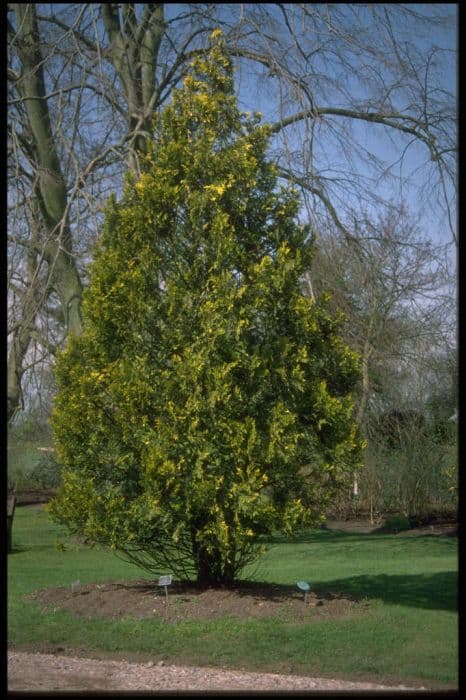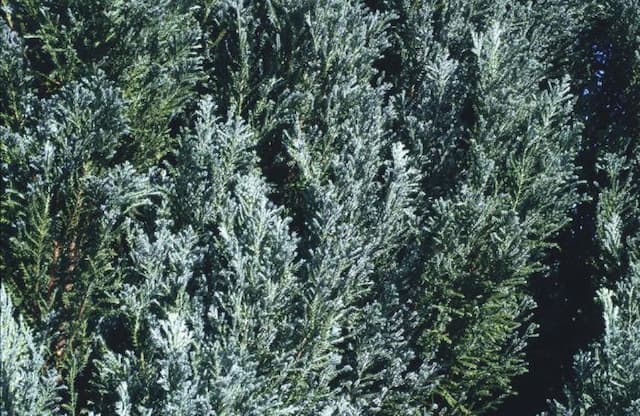Western Red Cedar Thuja plicata 'Stoneham Gold'

ABOUT
The Thuja plicata 'Stoneham Gold', commonly known as the Western Red Cedar, is a magnificent conifer that boasts a striking appearance. It is characterized by its lush, golden foliage that adds a shimmering, warm hue to any landscape. The foliage is arranged in flat sprays with scale-like leaves, which capture the light and lend a radiant glow especially when backlit by the sun. The leaves can exhibit various shades of gold, yellow-green, and even a hint of bronze depending on the season and light exposure, giving the plant a dynamic and vibrant look year-round. The Western Red Cedar displays a naturally pyramidal shape with a dense and compact form that tapers elegantly towards the top. Its branches grow in a horizontal or slightly drooping fashion, creating a luxurious texture that is both layered and feathery to the touch. This texture is further enhanced by the small, closely-arranged leaves, which provide a full and lush appearance. The foliage density also means that this plant is often used as a screen or hedge, providing privacy and visual interest. The bark of the Western Red Cedar is fibrous and stringy, sometimes displaying deep furrows and a reddish-brown color, which contrasts well with the golden foliage. Small, inconspicuous cones may also be present, adding an extra dimension to the plant's visual appeal. As an evergreen, the Western Red Cedar maintains its rich color throughout the seasons, offering year-round beauty. Its color and form make it a standout specimen in gardens, and it's often planted as a focal point where its glowing golden hue can be admired. Overall, the 'Stoneham Gold' cultivar of the Western Red Cedar is a showy and resilient plant that radiates beauty and provides a continuous display of color in any landscape.
About this plant
 Names
NamesFamily
Cupressaceae
Synonyms
Western Red Cedar, Giant Arborvitae, Western Arborvitae, Pacific Red Cedar, Shinglewood, Canoe Cedar
Common names
Thuja plicata.
 Toxicity
ToxicityTo humans
Western Red Cedar, as Thuja plicata 'Stoneham Gold' is commonly known, has low toxicity to humans. However, ingesting parts of the plant can cause mild stomach upset. The plant's essential oils, if consumed in large quantities, could lead to more severe digestive discomfort, including nausea, vomiting, and diarrhea. It's essential to teach children not to eat any plant material, including the foliage of the Western Red Cedar.
To pets
The Western Red Cedar has mild toxicity to pets. If an animal ingests part of the plant, it might experience gastrointestinal irritation. Symptoms in pets can include vomiting, diarrhea, and drooling. While generally not life-threatening, consumption of large quantities can lead to more severe health issues. Pets should be discouraged from chewing on or ingesting any part of the Western Red Cedar.
 Characteristics
CharacteristicsLife cycle
Perennials
Foliage type
Evergreen
Color of leaves
Gold
Height
20 feet [6 meters]
Spread
10 feet [3 meters]
Plant type
Tree
Hardiness zones
5
Native area
North America
Benefits
 General Benefits
General Benefits- Ornamental Appeal: Thuja plicata 'Stoneham Gold' has a striking golden-yellow foliage that provides visual interest and color to landscapes.
- Privacy Screening: It can be used as a hedge or screen to provide privacy due to its dense growth habit.
- Low Maintenance: The Western Red Cedar requires minimal pruning and care once established, making it user-friendly for gardeners of all levels.
- Foliage Year-Round: Being an evergreen, it retains its foliage throughout the year, offering constant beauty and privacy.
- Wildlife Habitat: It can serve as habitat and nesting space for birds, offering ecological benefits.
- Windbreak: Its thick foliage can act as a barrier against winds, protecting gardens and homes.
- Adaptability: It adapts well to a range of soil types, though it prefers moist, well-drained soil, ensuring successful growth in various conditions.
- Disease Resistance: Exhibits good resistance to most common pests and diseases, reducing the need for chemical treatments.
- Versatile Landscaping: Suitable for a variety of landscaping uses, including accent plantings, foundation plantings, and as a backdrop for flower beds.
- Climate Tolerance: It is tolerant of many climates, including coastal conditions, making it a resilient choice for different geographic locations.
 Medical Properties
Medical PropertiesThis plant is not used for medical purposes.
 Air-purifying Qualities
Air-purifying QualitiesThis plant is not specifically known for air purifying qualities.
 Other Uses
Other Uses- The fragrant leaves of the Western Red Cedar can be used in potpourris to add a forest-like aroma to your home.
- Wood from the Western Red Cedar, due to its resistance to decay, can be used to make durable outdoor sculptures and artistic installations.
- Branches and foliage can be incorporated into floral arrangements, wreaths, or garlands for decorative purposes.
- The bark of the Western Red Cedar can be stripped and woven into baskets or mats by traditional craftsmen.
- The fibrous bark is also suitable for creating ropes or cords in survival situations or for educational demonstrations of primitive technologies.
- The tree’s lightweight, yet strong wood can be carved into paddles or oars for canoes and other small boats.
- Dried and compressed foliage can be used to stuff pillows or fabric pouches, creating natural cushions with a mild cedar scent.
- The wood shavings and sawdust produced during the carpentry process can be repurposed as mulch for gardening to suppress weeds and retain soil moisture.
- The natural oils present in the wood can be extracted and used in the making of natural insect repellents.
- Cedar wood chunks or chips can be used for smoking meats to impart a unique flavor different from other types of wood.
Interesting Facts
 Feng Shui
Feng ShuiThe Western Red Cedar is not used in Feng Shui practice.
 Zodiac Sign Compitability
Zodiac Sign CompitabilityThe Western Red Cedar is not used in astrology practice.
 Plant Symbolism
Plant Symbolism- Longevity: Thuja plicata, commonly known as Western Red Cedar, is known for its long life and durability, symbolizing endurance and the ability to withstand the test of time.
- Protection: The Western Red Cedar has been traditionally used by indigenous peoples to create protective barriers and structures, representing safety and shelter.
- Healing: The tree has medicinal properties and has been used in various cultures for healing purposes, symbolizing health and recovery.
- Purification: Its aromatic wood and foliage are often associated with cleansing rituals and purifying spaces, representing spiritual and physical cleansing.
- Resilience: Able to grow in various conditions and climates, Western Red Cedar exemplifies adaptability and resilience in the face of adversity.
 Water
WaterThe Western Red Cedar "Stoneham Gold" requires regular watering to maintain moist, but not waterlogged soil. During the first growing season, water your plant deeply once or twice a week, depending on weather conditions. Mature plants are more drought-tolerant and should be watered deeply every two to three weeks, providing about 1 to 2 gallons per watering. Modify the watering schedule according to rainfall, less during rainy periods, and more during dry spells.
 Light
LightWestern Red Cedar "Stoneham Gold" thrives in full sun to partial shade. The best spot for planting is an area that receives at least four to six hours of direct sunlight daily, while also providing some shade during the hottest part of the day. Avoid deep shade locations, as this can affect the plant's growth and color.
 Temperature
TemperatureWestern Red Cedar "Stoneham Gold" is hardy and adaptable to a range of temperatures, flourishing in zones 5 through 7. The ideal temperature range for this plant is between 60 to 75°F. However, it can withstand temperatures as low as -20°F and as high as 80°F without significant damage.
 Pruning
PruningPruning Western Red Cedar "Stoneham Gold" is generally done to shape the plant or remove any dead or diseased branches. It is best to prune in the late winter or early spring before new growth starts. Pruning once a year is often sufficient for maintaining a desired size and promoting healthy growth.
 Cleaning
CleaningNot needed
 Soil
SoilFor Western Red Cedar 'Stoneham Gold,' the ideal soil mix should be well-draining with high organic matter content. A mixture of loam, peat, and coarse sand or perlite is recommended, with a slightly acidic to neutral pH of 6.0 to 7.5 for optimal growth.
 Repotting
RepottingWestern Red Cedar 'Stoneham Gold' generally does not require frequent repotting. Since it's a large, outdoor-growing conifer, repotting is replaced with transplanting young plants as they outgrow their initial space, usually done every few years, according to growth rate and landscape design.
 Humidity & Misting
Humidity & MistingWestern Red Cedar 'Stoneham Gold' prefers average to high humidity levels typical of outdoor environments; however, it is adaptable and can tolerate a range of humidity conditions as long as proper soil moisture is maintained.
 Suitable locations
Suitable locationsIndoor
Ensure bright light, ample space, and monitor soil moisture for indoor Western Red Cedar.
Outdoor
Plant in well-draining soil, full sun to partial shade, ensure ample space for growth for outdoor Western Red Cedar.
Hardiness zone
5-7 USDA
 Life cycle
Life cycleThe life of the Western Red Cedar 'Stoneham Gold' begins with seed germination, where its seeds, usually originating from cones, sprout in moist, well-drained soil conditions. After sprouting, the seedlings establish themselves through a juvenile phase, developing into young plants with characteristically golden-yellow foliage. As they enter the vegetative stage, the plants experience rapid growth and gradually adopt a pyramidal shape, with the foliage becoming more dense and vibrant. Reaching maturity, they start producing reproductive structures; the male cones release pollen, which fertilizes the female cones and leads to seed development. Once mature, the Western Red Cedar 'Stoneham Gold' can reproduce annually, with each cycle spreading seeds for potential new plants. The plant continues to grow in height and spread until it reaches its natural lifespan limit or is affected by external factors such as disease, climate conditions, or human activity.
 Propogation
PropogationPropogation time
Spring-Early Summer
The Western Red Cedar 'Stoneham Gold' is typically propagated through cuttings, and the best time to do this is in late summer to early fall. To propagate by cuttings, a gardener would select a healthy, semi-hardwood stem from the current year's growth. This stem should be about 5 to 6 inches (12.7 to 15.24 centimeters) long and contain several sets of leaves. The lower 1 to 2 inches (2.54 to 5.08 centimeters) of the cutting should be stripped of leaves and treated with rooting hormone for best results. The prepared cutting is then planted in a moist propagating medium, such as a mix of peat and perlite, and kept under conditions with adequate humidity and indirect light until rooting has occurred, which typically takes a few weeks to a couple of months.









